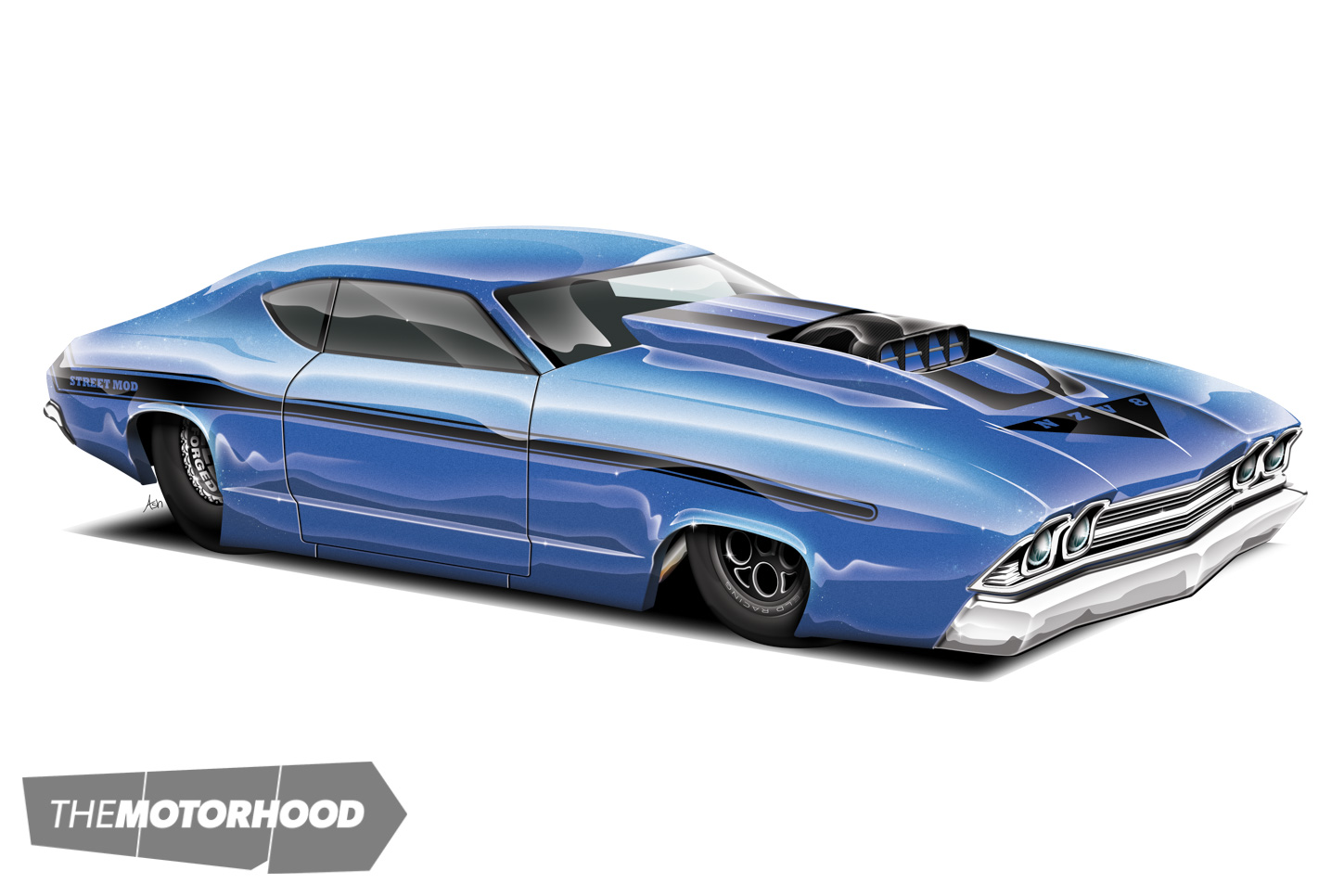data-animation-override>
“We’ve seen twice now what Warren Black can do when he gets his hands on an HQ Holden, so what would he do if he branched away from the iconic Aussie machines?”

“I’ve decided to stop racing the Monaro [coupe]; it’s too tidy and it’s getting wrecked — not to mention that it’s too heavy. I still love the quick street car thing, though, so have been thinking about building a car specifically for that. Going to America last year to watch drag week certainly put a few ideas in my head,” says Warren.
“To be at the pointy end, it’d need to be a full tube-frame construction, and, if we’re going that far, we may as well use a fibreglass body, seeing [as] the car will need to be registered as a scratch-built anyway. So, I’d grab one of the ’69 Chevelle bodies from Andy McCoy Race Cars and have Roger Binnema at Balclutha Automotive Services take care of the fabrication.
“I’m old school, so it’d need a blower, not turbos. I know it’d be a bit of a mission to get the blower height low enough, especially with a 14-71 on top of a 540-cube big block — we might have to do something special with the intake to get it all as low as possible, as well as have a dry sump to lower the engine down in the rails.
“It seems I’ve got a thing for expensive wheels — I’m thinking Weld Delta-1 Pro Mods would be a good look for it and also be strong enough.
“After having black cars, I’m over cleaning them, so, as it’s a Chevelle, the traditional Yenko blue with graphics would be the go — although maybe I’d change the graphics out from white to black to go with the wheels.”
LVVTA’s view:
Tony Johnson from the LVVTA says:
“The good thing about the LVV certification system is that, in principle, you can do almost anything you want, provided it’s safe — including [putting] a Pro Mod car on the street. In principle, there’s no reason you couldn’t use a tube frame or a fibreglass body. Lots of street-legal cars do exactly that. In fact, many years ago, during the build of my Hell Pizza ’56 Chev drag car, I thought seriously about making it street legal — and bear in mind that, although I never ran a supercharged engine, it was built as a Wild Bunch / Top Doorslammer type of car. I didn’t do it in the end, mainly for weight considerations — and because I got lazy!
“The main things to be aware of are as follows: Remember that, even though it would look like a Chevelle, it wouldn’t be a Chevelle; it would, in fact, be a new scratch-built vehicle, which means it would have to be right-hand drive. You would need to watch the blower and injector-hat height, as a sight-line requirement has to be met. I know having the top of the injector hat level with the roof looks cool, but the LVV cert system does have that silly requirement that the driver needs to be able to see where he’s going.
“You’d need an OE [original-equipment] laminated glass windscreen — not Perspex or polycarbonate — because you’d need windscreen wipers. The wheels and tyres would need to maintain the offset requirements — for the rears — and the front-to-rear width ratio specified in The New Zealand Car Construction Manual (formerly the NZ Hobby Car Technical Manual). Also, don’t forget that you’d need to design the frame, body, and floor with a full exhaust system in mind, so that the car could be kept quiet and legal on the street. A drag car only needs to stop once every hour or so, whereas a street car has be capable of stopping repeatedly without fade being introduced, so, whereas a drag car might run a smallish, non-vented disc on the front, a street car will generally need a bigger vented disc in order to dissipate heat between brake applications.
“One other very general thing — which would make a car like this tricky to build as a streeter (although not impossible) — is that it would have to be ‘drivable’. By that we mean that an LVV certifier has to be able to get in it and drive it safely on public roads. Lighting the rear tyres at 100kph if a light gust of wind touches the throttle pedal doesn’t align with the concept of being able to be driven safely, so a ‘street tune’ needs to be considered — all quite doable thanks to modern electronics.
“There are lots of other considerations, but, as Justin often says, the two key ingredients for ensuring you will be having a celebratory beer rather than a commiserative beer after your LVV certification inspection is completed are: (1) to follow The New Zealand Car Construction Manual very closely right from the start, and (2) to form a relationship with an LVV certifier early on, and — without driving him nuts with daily questions! — maintain contact with him, have him carry out inspections at each stage of the build, and follow his guidance carefully.
“Good luck!”




